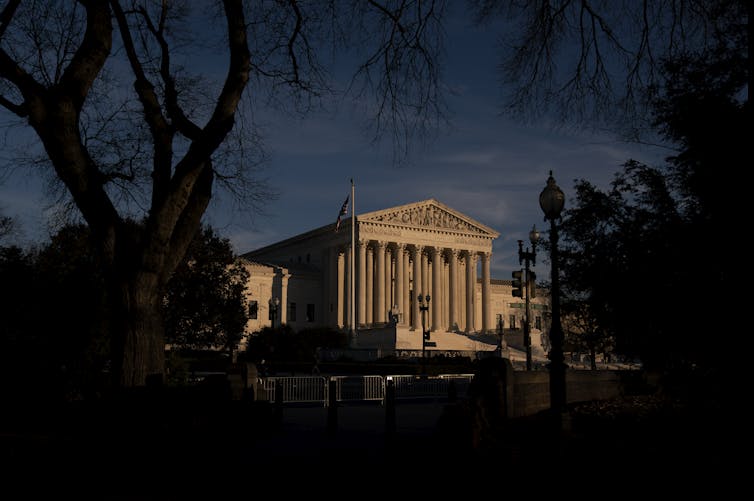
Experts in autocracies have pointed out that it is, unfortunately, easy to slip into normalizing the tyrant, hence it is important to hang on to outrage. These incidents which seem to call for the efforts of the Greek Furies (Erinyes) to come and deal with them will, I hope, help with that. As a reminder, though no one really knows how many there were supposed to be, the three names we have are Alecto, Megaera, and Tisiphone. These roughly translate as “unceasing,” “grudging,” and “vengeful destruction.”
I’ve been sitting on this one for a while because other things were going on, but I knoew I’d get to it eventually, because it is another piece of the Saving Democracy puzzle, and this seems like a good time.
================================================================
States pick judges very differently from US Supreme Court appointments

Stefani Reynolds/Getty Images
Joshua Holzer, Westminster College
The future of the U.S. Supreme Court is politically fraught.
The court’s partisan balance has long been a hot-button issue, and both Democrats and Republicans can correctly claim that the other party bears at least some blame for the politicization of the federal judiciary.
In 2016, appointments to the U.S. Supreme Court became even more overtly political when conservative Justice Antonin Scalia died and the U.S. Senate’s Republican majority refused to let President Barack Obama fill the vacancy.
This delay ultimately gave soon-to-be President Donald Trump the chance to seat conservative Neil Gorsuch as Scalia’s replacement. Four years later, though, Republicans rushed to fill the vacancy left by the death of liberal Justice Ruth Bader Ginsburg less than two months before a presidential election.
Now, with Democrats in control of the White House and – barely – the U.S. Senate, some within the party have been calling for President Joe Biden to add more justices to the U.S. Supreme Court in hopes of reversing Republican efforts to enshrine conservatism within the courts.
In response to those calling for reform, Biden has created the Presidential Commission on the Supreme Court of the United States, whose mission “is to provide an analysis of the principal arguments in the contemporary public debate for and against Supreme Court reform.”
This commission – which includes scholars, lawyers and political advisers – could look at top courts overseas for ideas about how to depoliticize the U.S. Supreme Court. But its members could also learn lessons from the states, many of which have already taken steps to insulate their judicial branches from partisan politics.
State court lessons for depoliticization
Following the model set by the U.S. Constitution, many state constitutions initially called for governors to appoint state judges for life with the advice and consent of the state’s Senate. Over time, many felt that this system empowered governors to award judgeships based upon party loyalty rather than judicial temperament and fair-mindedness.
In the mid-1800s, populism swept the country. This movement toward giving power to the public prompted several states to amend their state constitutions to allow for the popular election of judges.
This did not solve the problem of judicial politicization, as judges were often beholden to the political machines that helped them get elected. As such, the public began to perceive elected judges as both partisan and corrupt, and turned against the courts. For example, between 1918 to 1940 only two Missouri Supreme Court judges were reelected.
In 1940, Missouri became the first state to adopt what is now called the “Missouri Plan” for selecting judges, which involves two elements: “assisted appointments” and nonpartisan “retention elections.”
Typically, for assisted appointments, a nonpartisan commission reviews candidates for state judgeships, creating a list of potential nominees based on merit. The governor fills vacancies on the bench by choosing from this predetermined list. In such a system, the governor’s pick does not usually need to be confirmed by the state legislature because the pick has already been vetted by the nonpartisan commission.
For retention elections, judges face no opponent and are listed on the ballot without political party designation. Voters are simply asked whether an incumbent judge should remain in office, which provides an opportunity to oust judges who regularly make unpopular decisions. Retention elections are often held in states that use assisted appointments. However, in some states that still elect their judges using partisan elections, such as Illinois, nonpartisan retention elections are used when it’s time for reelection.
Today, more than 30 states use some form of assisted appointments. More than 20 states use some variation of retention elections. More than a dozen states use both in some capacity. Notably, both “red” states and “blue” states have adopted one or both of these reforms, as have many “purple” states.

AP Photo/Pablo Martinez Monsivais
Showing the way forward?
Advocates of Missouri’s nonpartisan court plan argue that the reforms have been a success. According to Sandra Day O’Connor, the first woman to serve on the U.S. Supreme Court, “the ‘Show-Me State’ … has shown the nation how we can do a better job of selecting our judges.”
If the federal government adopted assisted appointments, campaign tactics like Trump’s 2016 promise to appoint pro-life, conservative judges would be less relevant, because presidents would be limited in whom they could nominate for a court vacancy.
[Over 100,000 readers rely on The Conversation’s newsletter to understand the world. Sign up today.]
Additionally, if voters could remove U.S. Supreme Court justices whose opinions differ from that of the majority of Americans, politicians might not feel as pressured to block the appointment of a particular justice for partisan reasons, as the judge would serve on the bench for only as long as they retained public support.![]()
Joshua Holzer, Assistant Professor of Political Science, Westminster College
This article is republished from The Conversation under a Creative Commons license. Read the original article.
================================================================
Alecto, Megaera, and Tisiphone, appointing judges can certainly be a partisan exercise. But surely electing them can be just as partisan, if not indeed worse. Most of the timre I am inclined to respect the opinion of an officeholder, even a partisan one, over the opinion of the voters, given that they mostly have no idea who these judges are, any opinion they do have is derived from cheesy TV commercials, and those voters who do know something about judges are often in that position as a result of life experiences which make them ineligible to vote, temporarily or permanently. Of course there are exceptions … like the so-called “President” we had who was easily as uninformed as the dullest voter. The thing is, if your only choices are appointment and election, there really is no way to ensure you get the best judges.
The “assisted appointment” system, depending, as it does, on a nonpartisan commission, really does seem like a lifeline here. At least two of Trump**’s three nominees to the Supreme Court would never have made it into a pool provided by such a commission. My state is one of the states which uses both assisted appointments and retention elections – which are not like a recall, where there is an opposing candidate, but simply an up or down. If a judge were to lose, the commission would have to supply a new candidate pool to replace them.
Most voters have no idea who their state judges are or how qualified or what temperament, unless theyhave been to court. So it’s rare for a judge to lose a retention election. In the case of the Supreme Court and a national vote, I suspect that would change (and IMO for the better.)
I am looking forward to reading the discussion on this topic. It’s not something which is discussed a lot, but maybe it should be.
The Furies and I will be back.
6 Responses to “Everyday Erinyes #269”
Sorry, the comment form is closed at this time.

Yes, “assisted appointment” does seem to be the best option. My first, shooting from the hip, thought, was to go with electing judges, but you raised a really good point about voter ignorance.
Not, thank heaven, in my own state, but I have seen commercials for candidates for judge seats (presented as hporrible example) which pretty much consisted of puns on the name of tht candidate and sometimes on the name of his family. Not what you would call substantial (but difinitely cringworthy.)
I like those ideas. I’d also like for judges themselves to renounce political affiliation and not only vow to uphold and interpret the law without regard for who appointed them or their own political views (some already do, perhaps many) as the independent third branch of government they are in America. It isn’t that hard, or it shouldn’t be. All it requires is honor, and if one doesn’t have that, one should not be a judge of anything.
Great article, Joanne. :^)
Well said, Gene! Thanks!
I’ve long thought Supreme Court Justices should not be lifetime appointments….I am not a lawyer or legal scholar, but I understand The Constitution does not specify lifetime appointments….one thing I read mentioned “good behavior” which is interpreted as “life”….I wonder if they would have meant “health”….or “thought”…. also I understand the SC #s have varied over the years and are not set…
Like so many other things taken as “absolutes” from 245 years ago, its time to have a new discussion……
if judges cannot be apolitical…and its clear they’re not….then there needs to be some way that they can be replaced….either terms tied to the President that nominates them, the party in majority, or as much as I hate to say it….the people’s vote….which I really don’t think is a good idea, although in MN we vote for our judges…..
Colorado, my state, uses the “Missouri Plan.” and the retention votes seem to work reasonably well. There is no campaigning, which is what makes voting for judges really, really ugly and disgusting, IMO. After following the Derek Chauvin trial, I am aware you have at least oone good judge.